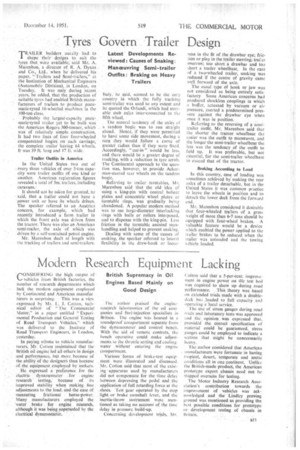Modern Research Equipment Lacking
Page 45

If you've noticed an error in this article please click here to report it so we can fix it.
British Supremacy in Oil Engines Based Mainly on Good Design
riONSIDERINC, the high output of lese vehicles from British factories, the number of research departments which lack the modern equipment employed by Continental and American manufac turers is surprising.This was a vim expressed by Mr. L. J. Cotton, tech nical • editor of Tire Commercial Motor," in a paper entitled "Experimental Production and General Testing of Road Transport Vehiclesaa which was delivered to the Institute of Read Transport Engineers, in London, yesterday.
In paying tribute to vehicle manufacturers, Mr. Cotton maintained that the British oil engine led all others in design. and performance, hut more beeause of the ability of thedesigner's than because
• of the equipment employed by 'makers. He expressed a preference for the electric dynamometer for . engine
researcb testing, because' . of • its improved stability when making fine adjustments to the load, and the ease Of measuring frictional horse-power.
• Many manufacturers employed the water brake for engine research, although it -was being superseded by the electrical dynamorfieter.
The author praised the engine research laboratories of the oil companies and feel-injection 'specialists in Britain. the engine was housed in a soundproof compartment separate from tIse dynamometer and control benelt. With the aid of remote controls, the bench operative could. make adjustments to the throttle setting and coalingwater without entering the engine compartntent.
Various forms of brake-test equipment were .illustrated and discussed. Mr. Cotton -said that most of the exist --apparatusused by manufacturers did not compensate for the lime delay between depressing the pedal and the application of full retarding force at the .shoes. Test gear operated by the stop light or brake camshaft lever, and the inertia-throw instrument were .menthaned as taking no account of the time delay in pressure build-up.
Concerning development lel r. Cotton said that a 5-per-Cent. improvement in engine power on the teat bed was required to show up during road perfOrmance. This theory was based on eetended trials made with a doubledeck bus loaded to full capacity and operating a local service.
The use of stress gauges during road trials and laboratory tests was approved and the opinion, was expressed that, ersivided the correct specification of material could be guaranteed, stress gauges could be employed to indicate a section that might be unnecessarily heavy.
'the author considered that American manufacturers were fortunate in having if-apical, desert, temperate and arctic conditions all in one continent. Unlike The British-made product, the American prototype expert chassis need not be shipped overseas for testing. • The Motor. Industry Research Association's contribution towards the improvement of vehicles was acknowledged and the Lindley proving ground was mentioned as providing the best possible conditions for prototype or development testing of chassis in
Britain. •




























































































